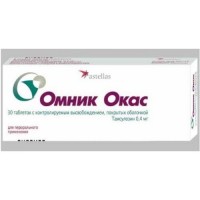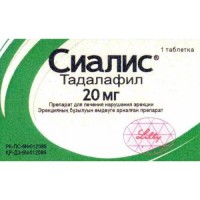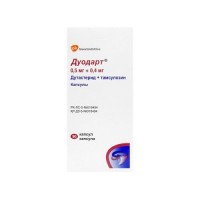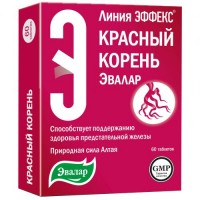TAMSOL® (Tamsulosin) 0.4 mg, 30 modified-release capsules
- $29.00
One capsule contains
After oral administration, it is well absorbed from the gastrointestinal tract (GIT) with a bioavailability of approximately 100%. When taken with food, the absorption of tamsulosin from the gastrointestinal tract is reduced. Identical conditions for absorption are created when taking the drug at the same time of day. Pharmacokinetics is linear. After taking one capsule, the maximum concentration (Cmax) of tamsulosin in the blood plasma is reached after about 6 hours. With repeated doses, the saturation stage occurs on day 5, while Cmax is ⅔ higher than after a single dose. With single and repeated doses, individual variability in plasma levels of tamsulosin is noted.
Communication with blood plasma proteins is 99%, the volume of distribution is low (0.2 l / kg).
Biotransformation is carried out in the liver, it is metabolized slowly, the phase of primary metabolism is insignificant. Most of tamsulosin is in plasma in unchanged form. Metabolites retain high selectivity for alpha-adrenergic receptors, but their pharmacological activity is low compared to tamsulosin. Tamsulosin does not induce microsomal enzymes.
The elimination half-life at a single dose is 10-13 hours. The excretion of tamsulosin and its metabolites is carried out mainly in the urine, 9% of the administered dose is excreted unchanged. In case of impaired renal function, dose adjustment is not required.
The therapeutic effect appears approximately 2 weeks after the start of treatment.
Tamsol selectively blocks postsynaptic α1A and α1D - adrenoreceptors of smooth muscles of the prostate, bladder neck, prostatic part of the urethra. As a result, there is a decrease in the tone of the smooth muscles of the prostate gland, the neck of the bladder, the prostatic part of the urethra, and the outflow of urine is facilitated.
At the same time, the symptoms of obstruction and irritation associated with benign prostatic hyperplasia are reduced.
To a lesser extent, it affects the alpha-adrenergic receptors of blood vessels, so the effect on systemic arterial pressure is insignificant.
- dysuric symptoms of the lower urinary tract due to benign prostatic hyperplasia.
Take orally, after meals, 1 capsule per day, at the same time of day. The capsule should not be broken into pieces or chewed, as this disrupts the prolonged release of the active substance.
- very often (>1%, <10%): dizziness (1.3%)
- often (>0.1%, <1%): headache, palpitations,
orthostatic hypotension, rhinitis, constipation, diarrhea, nausea, vomiting, rash, itching, urticaria, retrograde ejaculation, asthenia
- rarely (>0.01%, <0.1%): syncope, angioedema
- very rarely (<0.01%): priapism.
- hypersensitivity to any of the ingredients of the drug
- history of orthostatic hypotension
- severe liver dysfunction.
Does not interact with atenolol, enalapril, nifedipine, theophylline.
Cimetidine increases the concentration of tamsulosin in the blood plasma, furosemin - reduces. At the same time, the levels of all drugs remain within the normal range - a change in dosage is not required.
In in vitro studies , the level of the free fraction of tamsulosin did not change while taking diazepam, propranolol, trichlormethiazide, chlormadinone, amitriptyline, diclofenac, glibenclamide, simvastatin and warfarin.
Tamsulosin does not affect the free fraction of diazepam, propranolol, trichlormethiazide and chlormadinone.
In in vitro studies of the liver microsomal fraction (enzyme system of drug metabolism associated with cytochrome P450), tamsulosin did not interact with amitriptyline, salbutamol, glibenclamide and finasteride.
Diclofenac and warfarin increase the excretion of tamsulosin.
Tamsulosin may enhance the hypotensive effect of other drugs (anesthetics, alpha 1 - blockers).
Like other alpha1-blockers, Tamsol can cause a decrease in blood pressure, in rare cases causing fainting. At the first signs of orthostatic hypotension (dizziness, weakness), it is necessary to seat or lay the patient down until the symptoms disappear.
Treatment with Tamsol should be preceded by a preliminary examination of the patient in order to exclude any other disease that occurs with complaints similar to the disease of benign prostatic hyperplasia. Treatment should be preceded by preliminary rectal digital examination of the prostate and measurement of the level of specific prostate antigen, which are regularly repeated later in the course of treatment.
In severe renal failure (creatinine clearance < 10 ml / min), the use of the drug requires special care due to the lack of sufficient clinical experience.
Features of influence on the ability to drive a car and potentially dangerous mechanisms
The drug can cause drowsiness, decreased visual acuity, dizziness and fainting in some patients. Therefore, care must be taken.
There are no data on cases of acute overdose. In acute overdose, hypotension and other side effects may increase.
Treatment : the patient is given a horizontal position of the body. In order to prevent absorption, induce vomiting, when taking large doses - gastric lavage, the appointment of activated charcoal, the introduction of an osmotic laxative (sodium sulfate).
If necessary, drugs are additionally administered to restore the volume of circulating blood, vasopressors. Monitor renal function; dialysis is ineffective due to the high affinity of tamsulosin for plasma proteins.
Store in original packaging at 15-30°C.
Keep out of the reach of children!
Shelf life - 2 years
Do not use after the expiration date.
- Active ingredient - Tamsulosin hydrochloride 0.40 mg,
- Excipients: calcium stearate, triethyl citrate, talc, copolymer of methacrylic acid and ethyl acrylate (1:1), also containing polysorbate 80 and sodium lauryl sulfate, microcrystalline cellulose.
Pharmacological properties
Pharmacokinetics
After oral administration, it is well absorbed from the gastrointestinal tract (GIT) with a bioavailability of approximately 100%. When taken with food, the absorption of tamsulosin from the gastrointestinal tract is reduced. Identical conditions for absorption are created when taking the drug at the same time of day. Pharmacokinetics is linear. After taking one capsule, the maximum concentration (Cmax) of tamsulosin in the blood plasma is reached after about 6 hours. With repeated doses, the saturation stage occurs on day 5, while Cmax is ⅔ higher than after a single dose. With single and repeated doses, individual variability in plasma levels of tamsulosin is noted.
Communication with blood plasma proteins is 99%, the volume of distribution is low (0.2 l / kg).
Biotransformation is carried out in the liver, it is metabolized slowly, the phase of primary metabolism is insignificant. Most of tamsulosin is in plasma in unchanged form. Metabolites retain high selectivity for alpha-adrenergic receptors, but their pharmacological activity is low compared to tamsulosin. Tamsulosin does not induce microsomal enzymes.
The elimination half-life at a single dose is 10-13 hours. The excretion of tamsulosin and its metabolites is carried out mainly in the urine, 9% of the administered dose is excreted unchanged. In case of impaired renal function, dose adjustment is not required.
The therapeutic effect appears approximately 2 weeks after the start of treatment.
Pharmacodynamics
Tamsol selectively blocks postsynaptic α1A and α1D - adrenoreceptors of smooth muscles of the prostate, bladder neck, prostatic part of the urethra. As a result, there is a decrease in the tone of the smooth muscles of the prostate gland, the neck of the bladder, the prostatic part of the urethra, and the outflow of urine is facilitated.
At the same time, the symptoms of obstruction and irritation associated with benign prostatic hyperplasia are reduced.
To a lesser extent, it affects the alpha-adrenergic receptors of blood vessels, so the effect on systemic arterial pressure is insignificant.
Indications for use
- dysuric symptoms of the lower urinary tract due to benign prostatic hyperplasia.
Dosage and administration
Take orally, after meals, 1 capsule per day, at the same time of day. The capsule should not be broken into pieces or chewed, as this disrupts the prolonged release of the active substance.
Side effects
- very often (>1%, <10%): dizziness (1.3%)
- often (>0.1%, <1%): headache, palpitations,
orthostatic hypotension, rhinitis, constipation, diarrhea, nausea, vomiting, rash, itching, urticaria, retrograde ejaculation, asthenia
- rarely (>0.01%, <0.1%): syncope, angioedema
- very rarely (<0.01%): priapism.
Contraindications
- hypersensitivity to any of the ingredients of the drug
- history of orthostatic hypotension
- severe liver dysfunction.
Drug Interactions
Does not interact with atenolol, enalapril, nifedipine, theophylline.
Cimetidine increases the concentration of tamsulosin in the blood plasma, furosemin - reduces. At the same time, the levels of all drugs remain within the normal range - a change in dosage is not required.
In in vitro studies , the level of the free fraction of tamsulosin did not change while taking diazepam, propranolol, trichlormethiazide, chlormadinone, amitriptyline, diclofenac, glibenclamide, simvastatin and warfarin.
Tamsulosin does not affect the free fraction of diazepam, propranolol, trichlormethiazide and chlormadinone.
In in vitro studies of the liver microsomal fraction (enzyme system of drug metabolism associated with cytochrome P450), tamsulosin did not interact with amitriptyline, salbutamol, glibenclamide and finasteride.
Diclofenac and warfarin increase the excretion of tamsulosin.
Tamsulosin may enhance the hypotensive effect of other drugs (anesthetics, alpha 1 - blockers).
Special instructions
Like other alpha1-blockers, Tamsol can cause a decrease in blood pressure, in rare cases causing fainting. At the first signs of orthostatic hypotension (dizziness, weakness), it is necessary to seat or lay the patient down until the symptoms disappear.
Treatment with Tamsol should be preceded by a preliminary examination of the patient in order to exclude any other disease that occurs with complaints similar to the disease of benign prostatic hyperplasia. Treatment should be preceded by preliminary rectal digital examination of the prostate and measurement of the level of specific prostate antigen, which are regularly repeated later in the course of treatment.
In severe renal failure (creatinine clearance < 10 ml / min), the use of the drug requires special care due to the lack of sufficient clinical experience.
Features of influence on the ability to drive a car and potentially dangerous mechanisms
The drug can cause drowsiness, decreased visual acuity, dizziness and fainting in some patients. Therefore, care must be taken.
Overdose
There are no data on cases of acute overdose. In acute overdose, hypotension and other side effects may increase.
Treatment : the patient is given a horizontal position of the body. In order to prevent absorption, induce vomiting, when taking large doses - gastric lavage, the appointment of activated charcoal, the introduction of an osmotic laxative (sodium sulfate).
If necessary, drugs are additionally administered to restore the volume of circulating blood, vasopressors. Monitor renal function; dialysis is ineffective due to the high affinity of tamsulosin for plasma proteins.
Storage conditions
Store in original packaging at 15-30°C.
Keep out of the reach of children!
Shelf life - 2 years
Do not use after the expiration date.








